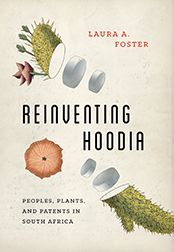
Abstract: "Native to the Kalahari Desert, Hoodia gordonii is a succulent plant known by generations of Indigenous San peoples to have a variety of uses: to reduce hunger, increase energy, and ease breastfeeding. In the global North, it is known as a natural appetite suppressant, a former star of the booming diet industry. In Reinventing Hoodia, Laura Foster explores how the plant was reinvented through patent ownership, pharmaceutical research, the self-determination efforts of Indigenous San peoples, contractual benefit sharing, commercial development as an herbal supplement, and bioprospecting legislation.
Using a feminist decolonial technoscience approach, Foster argues that although patent law is inherently racialized, gendered, and Western, it offered opportunities for Indigenous San peoples, South African scientists, and Hoodia growers to make unequal claims for belonging within the shifting politics of South Africa. This radical interdisciplinary and intersectional account of the multiple materialities of Hoodia illuminates the co-constituted connections between law, science, and the marketplace, while demonstrating how these domains value certain forms of knowledge and matter differently."
Laura Foster, "Foster, Laura A. 2017. Reinventing Hoodia: Peoples, Plants, and Patents in South Africa. Feminist Technosciences. Seattle: University of Washington Press.", contributed by Angela Okune, STS Infrastructures, Platform for Experimental Collaborative Ethnography, last modified 8 August 2018, accessed 3 April 2025. https://stsinfrastructures.org/content/foster-laura-2017-reinventing-hoodia-peoples-plants-and-patents-south-africa-feminist
Critical Commentary
AO: This 2017 book by Laura Foster examines how hoodia, a patented plant found in Southern Africa historically circulates and changes meaning through colonial botanical sciences, patent law rules, ethno-pharmaceutical research, contractual benefit sharing, and sustainable fair trade practices.